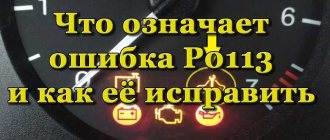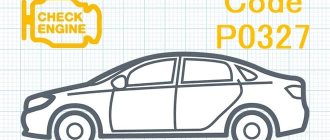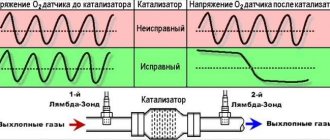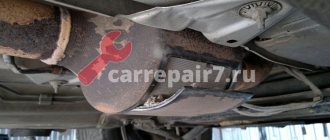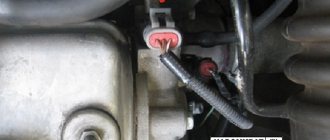p0504
Also, many owners of a Lada Priora with 16 valves have questions about the appearance of error p0504. She tells the owner that there is a malfunction in the brake pedal sensor. To find out the exact reason for the appearance of p0504, you need to remove the sensor and disassemble it. Pay attention to its springs, one of them could burst - replace the damaged part.
see also
Another reason is copper contacts, which can burn. Inspect them and clean them if necessary. Sometimes error p0504 pops up due to the incorrect position of the brake pedal sensor on Priora 16. Twist it and check whether codes p0504 remain on the screen or not.
Error P0504
This malfunction is associated with an incorrect signal from the brake pedal switches. Most often, the cause of such a failure is a malfunction of the brake pedal position sensor, lack of proper adjustment, or a broken spring that is installed in this device. Procedure for checking and troubleshooting:
Sensor locations on video:
Adjusting the brake pedal position sensor:
Any driver can carry out this procedure at home without a trip to a service station. The part has two nuts in its design. One of them is on top, and the second is on the bottom. The upper nut adjusts the pressure of the rod. First you need to release the lower one, and then tighten the upper one, thereby changing the gap of the element. You need to ensure that the rod is fully pressed and not partially pressed. After this, start the car and let it run for about 10 minutes to check if the error appears.
Error 0422
The efficiency of the Priora 16 neutralizer has fallen below the normal level - this is what error p0422 reports to the owner of the Lada Priora 16 valves. As practice shows, codes 0422 pop up quite rarely. If code 0422 appears on the on-board computer screen, then you need to perform the following steps:
To get rid of 0422 you will need to reflash the cathode collector. If you have the equipment to set the settings, you can do the work yourself.
What does Bank 1, Bank 2 mean?
The designation Bank 1 and Bank 2 is usually used if the vehicle has more than four cylinders. But it is also used on four-cylinder engines.
This means that you probably have two exhaust pipes or that the engine cylinders are split into multiple O2 sensors. “Bank” indicates which side or exhaust pipe the sensor is located on.
Bank 1 is always installed on cylinders 1-3-5-7-9, etc. Bank 2 sensor monitors cylinders 2-4-6-8-10.
You can disable one oxygen sensor and read errors with the OBD2 scanner. This will allow you to find out where the sensor is installed - in Bank 1 or Bank 2.
p1558
This error usually occurs on cars with a 127 engine. It is associated with the throttle valve, the quality of which in this power plant leaves much to be desired. P1558 does not interfere with normal engine operation, but you can still try to fix it. Some people solve the problem by flashing it, but we offer a simpler method.
Remove the throttle valve, and then remove the cover - this can be done using a hexagon. We find a plastic gear inside - this is the working part. Lubricate the gear thoroughly and reassemble in reverse order. Most likely, error p1558 will disappear after these manipulations.
Error 1602
If error 1602 appears on the on-board computer of the Lada Priora 16 valves, this means that the on-board voltage in the controller has dropped. As the experience of VAZ 2170 owners shows, error 1602 does not affect the operation of the car; if you remove the terminal from the battery, then 1602 will disappear, but after a while it will appear again. There may be several reasons for 1602:
- Problems with the generator. Measure its voltage; in good condition it produces 13.7-14 V.
- A large voltage drop during engine starting also leads to the appearance of 1602. The ECU records the voltage drop and automatically adjusts the time. First of all, you need to check the ground on the electronic control unit.
- Codes 1602 appear when the security system blocks one of the electrical circuits.
How is self-diagnosis performed?
We have sorted out the main errors on the Priora, now it’s worth finding out how self-diagnosis is performed. The VAZ 2170 with 16 valves has a special controller with which diagnostics are performed. If you have an on-board computer installed, then diagnostics are performed on it. There is also special equipment that allows for a more in-depth check of Priora 16 class systems.
Since most Priora 16 cars already have an on-board computer, we will consider the option without the use of special devices. Diagnostics begins with activation of the test mode. The work proceeds according to the following scheme:
Error P1602
This failure occurs due to a loss of supply voltage to the ECU.
Things to check:
- Battery charge. A fully charged battery has a voltage of 12.8 Volts when the engine is off, and while the engine is running it averages 13.8 Volts .
- Oxidation of terminals. If present, it must be cleaned.
- Reliability of ground contacts or current leakage in the vehicle power circuit.
- Status of 18th power supply pin of the engine control controller.
Location of the 18th ground contact on the VAG block
Trouble P0422 - Main Catalytic Converter Bank 1 Efficiency Less Than Required
Trouble P0422 is a general trouble code that indicates that the primary catalytic converter (bank 1) efficiency is below acceptable levels. Catalyst efficiency is determined by the transmission control module (PCM), which uses exhaust gas and temperature data from oxygen sensors located upstream and downstream of the catalytic converter to determine efficiency. If the readings from both sensors match or are almost identical, this indicates that the catalyst efficiency is most likely below acceptable levels. In this case, error P0422 will appear.
How to Troubleshoot or Reset Trouble Code P0422
Some suggested steps to troubleshoot and fix error code P0422:
- Inspect the sensor wires located near the catalyst.
- Check the oxygen sensors.
- Repair engine leaks.
- Test the air flow sensor as well as the manifold air pressure.
- Check the fuel pressure regulator.
- Test the engine coolant temperature sensor.
- If no problems are found, check the catalytic converter and replace it if necessary.
Autotime
Reviews. Auto News. Test drives
Main Menu
Error P0422 - Main catalyst performance too low (bank 1)
Trouble code P0422 is a standard OBD-II trouble code. Code P0422 indicates that the efficiency of the main catalyst is below acceptable levels. Catalyst efficiency is determined by the engine control module, which uses exhaust gas and temperature data from both the upstream and downstream oxygen sensors to determine catalyst efficiency. If the sensor readings at the input and output are too similar, then the efficiency of the catalyst will most likely be below the acceptable level and the control unit will record error P0422.
Causes of error P0422
The most common cause of the P0422 code is a faulty catalytic converter. However, there are many other problems that can cause the catalytic converter to malfunction (or may cause it to fail), including the following:
Symptoms of the error
With error P0422, there are no noticeable symptoms (except for the stored error code and the “Check engine” signal on the instrument panel). In rare cases, engine power may drop, vibration may appear during acceleration, and the engine may stall or not start.
Diagnosis of error P0422
Diagnosis of error P0422 is carried out using an OBD-II fault code scanner. First you need to read the stored error codes. After this, clear all saved errors and start the car. If no error is returned, then most likely there is no problem.
On which cars is this problem most common?
The problem with code P0422 can occur on different machines, but there are always statistics on which brands this error occurs more often. Here is a list of some of them:
- Audi
- Chevrolet
- Chrysler
- Dodge (Dodge Caravan)
- Ford
- Hyundai (Hyundai Accent, Elantra)
- Kia (Kia Spectra, Sportage)
- Mercedes
- Mitsubishi
- Peugeot (Peugeot 206)
- Volkswagen (Volkswagen Beatle, Jetta)
- Volvo
- VAZ 2104, 2105, 2107, 2110, 2111, 2112, 2113, 2114, 2115
- Volga Chrysler, 31105
- Gazelle Business, Next
- Lada Vesta, Granta, Kalina, Niva, Priora
- UAZ
With fault code P0422, you can sometimes encounter other errors. The most common are the following: P0304, P0326, P0420, P0441, P0455.
Buy a minibus and drop it off. The error only appears on the highway. When the error pops up that the second dk is dead, then replace it with a bosch.
According to readings on the forums, the problem often occurs not in the first gases. There seems to be a firmware update out now, but it’s lazy to go crazy over such a trifle.
The action plan is approximately this: You can try to swap the DCs and see what happens. VAZ supplies Delphi cultural centers, which are not of high quality.
In general, there are certain instructions in this regard:
Error 0422 – Neutralizer efficiency below threshold The error is entered under the following conditions: 1. there are no errors 0102, 0112, 0113, 0116, 0117, 0118, 0122, 0123, 0130, 0132, 0134, 0136, 0137, 0138, 0140, 0171, 0172 , 0300, 03**, 0441, 0444, 0445, 0562, 0563. 2. The ECU controls the fuel supply in a closed loop Parameter (B_LR= “YES”). 3. The conditions for the ECU to carry out the catalyst diagnostic cycle have been met. 4. The ECU has determined that the oxygen content after the neutralizer is above the threshold. The error is entered into the ECU memory on the third drive cycle. The efficiency of the neutralizer can be assessed using the ANKAT parameter (neutralizer efficiency factor). If the ANKAT value tends to zero, the neutralizer is working effectively. The larger the ANKAT value, the more the neutralizer degrades. Check procedure: 1. Turn off the ignition, connect the diagnostic tool, turn on the ignition, check for errors. If there are other errors in the ECU memory, we eliminate them first. 2. If there is an error, inspect the catalytic collector for damage, check the condition of the “filling”. 3. If malfunctions are found, replace the catalytic collector; if there are no comments, check the exhaust system between the neutralizer and the main muffler for leaks, incompleteness, or damage. Make sure that there is no damage to the DDC and that the wiring harness is not damaged. If no faults are found, replace the neutralizer. 4. If faults are found, fix them. Start the engine, warm it up to a coolant temperature of 70 degrees. Set the rotation speed of the HF to 2000 - 3000 rpm for at least 4 minutes. The load on the engine should have a stable value of 15 - 50%. If the error does not appear, the malfunction has been eliminated; if the error appears again, replace the neutralizer.
2 years ago AutoTime 0
Trouble code P0422 is a standard OBD-II trouble code. Code P0422 indicates that the efficiency of the main catalyst is below acceptable levels. Catalyst efficiency is determined by the engine control module, which uses exhaust gas and temperature data from both the upstream and downstream oxygen sensors to determine catalyst efficiency. If the sensor readings at the input and output are too similar, then the efficiency of the catalyst will most likely be below the acceptable level and the control unit will record error P0422.
Test methods and problem solving
In some cases, it is necessary to check the serviceability of the oxygen sensor or the exhaust system and manifold for leaks. Leaks and leaks can affect the operation of the O2 sensors and cause the P0420 error code to appear, but still, more often this problem is directly related only to the condition of the catalyst.
Some tips for a troubleshooting plan
Before starting diagnostics, in order to save time on finding out the cause and fixing the problem, we advise you to carry out a few simple checks, and then proceed to further, complex solutions to the problem. So:
Checking the operation of the catalytic converter and its parameters
To assess the efficiency of the catalyst, it is necessary to compare the output voltage graphs between the “upper” and “lower” oxygen sensors, as well as look at the fuel supply adjustment data.
Oxygen sensor readings on an oscilloscope
The output voltage of the oxygen sensor, read by the car's computer, will decrease when the mixture is lean and increase when it is rich. A normal reading for an oxygen sensor will fluctuate between 900 millivolts (rich condition) and 100 millivolts (lean condition).
Short-term adjustment, ideally, should tend to “0”, but on an engine with mileage, deviations from the norm of up to 10% are acceptable. And when the fuel adjustment exceeds 25%, then a long-term adjustment also occurs, so if both values are present, this indicates a problem in preparing the fuel-air mixture. Therefore, pay attention to the presence of additional fault codes.
How to troubleshoot P0420
Some car owners, unaware of the origin of the P0420 error, may begin to eliminate the problem by cleaning the damper or replacing sensors that affect air and fuel consumption. While, if you need to try to replace something, it’s this:
Firstly, swap lambda probes , upper and lower, since they are the same and can replace each other. Therefore, if the problem is precisely the non-working second oxygen sensor, then the error code will change (alternatively, error P0134 may appear).
Secondly, fill up with other gasoline , of better quality, and drive a little (if it’s because of the fuel, then a couple of days will change the situation).
The third step towards troubleshooting can be checking the catalyst , or rather, its throughput (there are several methods). Internal catalyst failure usually occurs due to abnormal operation of the engine systems upstream of the catalyst. An increased operating temperature of the converter is usually the cause of both the appearance of this code and its failure. For example, misfires can lead to elevated catalyst operating temperatures.
Symptoms
If an error code with the value P0420 is registered in the ECU, this can be guessed not only by scanning the control unit and connecting it with a scanner.
Most often, suspicions about a faulty catalyst arise from indirect signs. Yes, they can indicate other possible problems.
Since error P0420 appears not only in a situation where the catalyst fails, the symptoms can be quite varied. Namely:
- the engine does not work as well as before;
- dynamics decreases;
- at idle the engine behaves unstable;
- engine starting becomes more difficult;
- fuel consumption increases noticeably without increasing the load;
- during movement, a cracking sound occurs on the side of the catalyst;
- the exhaust gas changes its composition and color may change;
- the smell from the exhaust becomes more pronounced and unpleasant, sometimes sharp;
- The warning light on the dashboard, known to everyone as the Check Engine, comes on.
The majority of signs, apart from the crackling sound from the catalyst itself, potentially indicate various problems. But the manifestation of any of the symptoms discussed is a good reason to engage in diagnostics, find out the causes and try to troubleshoot.
How does a mechanic diagnose a P0422 code?
Error P0422 can be diagnosed using a standard OBD-II scanner. The mechanic uses a scanner to view data and gather information about the code, as well as check for other error codes that may be present. The mechanic will then clear the error codes from the PCM memory and retest the system to see if P0422 appears again. If the code disappears, it may indicate an intermittent error or that the code appeared in error.
If the P0422 code appears again, have a mechanic inspect the wires and connectors near the catalytic converter. He will repair or replace any damaged items. The mechanic will then inspect the catalytic converter and also perform a thorough check of the exhaust system for leaks.
If the catalytic converter is the problem, the mechanic will examine other vehicle components to determine the cause of the catalytic converter damage.
Common errors when diagnosing code P0422
The most common mistake when diagnosing a P0422 code is failure to follow the diagnostic protocol, which leads to hasty replacement of the catalytic converter. Before replacing the catalyst, it is necessary to eliminate the cause of its damage, and also consider other error codes present.
It is also a mistake to hastily replace oxygen sensors. Before replacing them, it is necessary to perform a thorough diagnosis, since usually a faulty sensor is not the only cause of the P0422 error.
Decoding errors
Each code consists of five characters: P 1 4. Let's say right away about the fourth and fifth characters - they indicate the serial number of the error. Now it’s worth taking a closer look at what the codes consist of
The first character may vary depending on the vehicle system:
- P – malfunctions in the operation of the power plant; the symbol also indicates defects in the automatic transmission.
- U – you need to look for a fault in the interaction node between the system units.
- B – defects in the operation of body systems, which include electric lifts, airbags, etc.
- C – chassis sensors have detected a malfunction in the chassis system.
Let's move on to the second character:
- 3 – reserve.
- 2 and 1 – codes set by the manufacturer.
- – common code for on-board diagnostics (OBD-II).
How serious is the P0422 code?
The severity of the P0422 code depends on the cause of its occurrence. If the problem is a bad catalytic converter, the engine may stall frequently or be difficult to start. In this case, problems with the vehicle's handling may occur. However, if everything is in order with the catalyst, there should not be any serious problems. In any case, if this code is detected, it is recommended that you contact a qualified technician as soon as possible to diagnose and repair the error to avoid serious damage to the catalytic converter.
What does it indicate?
The occurrence of error P0420 makes it clear to the car owner that not everything is in order with the operation of the catalyst and it is not able to cope with the entire volume of incoming exhaust gases. However, this does not always mean that the catalyst has failed. It is likely that it became clogged and this, in turn, negatively affected the throughput.
It is important to note that if there are two neutralizers on one car, this error code is P0430. This is typical for vehicles of Euro 3 standard from above.
Conditions for generating DTC P0420
The ECM, in the process of monitoring, compares the signals of the 1st and 2nd sensors during a given time interval, calculating the duration of the voltage signal, and if it goes beyond a given threshold, the “brain” of the car interprets this as a malfunction of the neutralizer. The threshold value of the difference between the amplitudes of the front S1 (taken as the standard) and rear S2 oxygen sensors is more than 0.7 times per minute. But the check light, indicating that an error has been recorded in the memory of the ECM unit, does not light up instantly, but only when a decrease in the performance characteristics of the catalytic converter occurs for 100 seconds, and the engine load should be from 21 to 63% when the crankshaft rotates 1,720 - 2,800 rpm, and the catalyst temperature exceeds 500 degrees.
Signal from oxygen sensor
During normal operation of the catalytic converter, the downstream heated oxygen sensor signal switches slowly between rich and lean conditions. Frequent switching of the lambda probe between these states indicates a decrease in the efficiency of the converter. As a result, its ability to accumulate oxygen is reduced.
The task of the catalyst is to oxidize carbon monoxide and neutralize CO2 hydrocarbon emissions in order to reduce the concentration of harmful substances. This process, starting with the Euro 3 standard, is monitored by two oxygen sensors. There is a constant comparison of the signals of the first and second lambda in order to register the convergence of their readings. Therefore, error code P0420, in due time, will bother all owners of cars, including VAZ, Nissan, Toyota, Chevrolet, Ford, Honda or others produced after 1996 and having 2 lambda probes in the exhaust system.
Trouble code P0420 appears when oxygen and unburnt fuel residues are detected in the exhaust gases.
What does code P0420 mean?
P0420 is triggered in the Electronic Control Unit (ECU) when there is a problem with the performance of the catalytic converter. The controller uses two oxygen sensors - one before and one after the catalyst to measure its efficiency. The error occurs if the converter or oxygen sensor malfunctions, which begins to transmit incorrect data.
We receive many messages asking about the P0420 code. It keeps coming back after several repairs and you just end up spending more and more money on auto repair work. This trouble code may confuse you because there is a lot of misinformation about it.
Catalytic converter
If the rear oxygen sensor receives incorrect values, a P0420 fault will be stored in the ECU. This could be due to a faulty catalytic converter or one of the O2 sensors failing. There may also be many other problems with the engine that are destroying the catalytic converter, and if you install a new one, it may be damaged again.
The oxygen sensor is also called a lambda probe.
Many people think that a lean or rich mixture can cause this error code. Yes, it is possible, but not in the way you think. A rich or lean mixture can damage the catalytic converter and when it is damaged/full of fuel it will be low in efficiency and the rear oxygen sensor will see this and trigger a P0420 code.
What repairs can fix the P0422 code?
To resolve error P0422 you may need to:
Additional comments for troubleshooting P0422
If the cause of this error is a faulty oxygen sensor, other error codes related to this sensor may also appear along with the P0422 code.
Car manufacturers are required to provide a 100,000 kilometer warranty on the catalytic converter. If the catalyst is damaged or fails, you need to find out whether it can be replaced under warranty.
Reasons for the error
A P0422 code may mean that one or more of the following problems have occurred:
- Bad or non-functional catalyst.
- Oxygen sensor malfunction.
- The engine is running without the optimal air/fuel ratio.
- The engine coolant temperature sensor has failed.
- Leak in the engine before the catalytic converter.
- Misfires in engine cylinders.
- Damage to wires and connectors.
- Problems with the manifold air pressure sensor.
- Contamination of the engine oil due to non-regular replacement.
- The air flow sensor has failed.
- Malfunction of the fuel pressure regulator.
The efficiency of the main neutralizer block 1 is below the threshold
From the moment I bought the car, literally in the first thousand kilometers, I began to be haunted by one single error “P0422 Converter efficiency below the threshold”, it is periodically registered in the ECU and not long after that it pops up on the instrument panel “CHECK”. I’ll immediately erase the staff and continue riding, approximately between “CHECKS” the mileage is around 400 - 500 km. It looks like it still sits from the manufacturer's factory. It’s as if my upbringing tells me that this is a mistake and needs to be corrected. What has already been double-checked a hundred times:
1) The spark plugs are all new, 3 sets just for fun and nothing changes, there is no plaque on them, the gaps are clear, the insulators are intact. 2) The wires to the armor were tested for both integrity and resistance, I tried to test it from a working machine and there was no difference. 3) The coil was removed and checked, I also used Kalina 2 and the result was the same. 4) The fuel rail with injectors was removed and tested in a bench, the spray was excellent, the same, just in case I washed it, in one flask, unlike the other three, it was a fraction of a millimeter smaller than in the others, but the flask was 15 centimeters and half a millimeter, just a miracle result. 5) The filters are all new, I change them along with the oil every 6-7 thousand km. 6) The timing and timing gear marks are all clear. 7) The clearances in the gas distribution mechanism are excellent, they were recently rechecked. I’ve already forgotten the specific compression number, but this is what I remember, it’s the same in all cylinders, everything is clear and not low. 9) The pressure in the fuel rail was checked, everything seems to be normal, I checked it two years ago. I can’t say for sure now. 10) The sensors were not touched at all. 11) Gasoline is used only by G95, and by the way, I noticed a tendency that the “CHECK” usually pops up 300-400 meters after refueling.
What are the symptoms and abnormalities:
1) The non-original ECU was changed right during pre-sale preparation in the showroom with the same only blue standard Granta 2) From the sound in the video you can hear that there is a certain misfire, as if one cylinder is out of tune, a small misfire is a barely audible pop 3) Engine speed at idle are not stable and wander a little around 90-100 rpm. min. Well, something like this. I'm waiting for advice! Give up another year with this sore, or still suffer.
VAZ fuel-injected cars have a special engine control and diagnostic system called an ECU (electronic control unit). With its help, you can get acquainted with malfunctions that arose during the operation of the car. VAZ 2110, 2114, 2115 cars and the procedure for eliminating them.
VAZ ERRORS AND THEIR SOLUTIONS
Owners of domestic cars can easily find a problem with their car. This became possible thanks to the use of on-board computers and the introduction of modern equipment diagnostic tools. This article will describe in detail the errors and how to eliminate them in VAZ 2110, 2112, 2114, Kalina, Priora and how to eliminate them.
How to diagnose a car yourself
Do not rush to go to the service center. Although specialists use test benches to detect malfunctions, and their diagnostics are more accurate, every car owner is still able to find out the cause of the problem using information about the error codes of the on-board computer.
To view error codes recorded by the controller:
01 – Sit behind the wheel, then press and hold the odometer button. It is located at the bottom of the dashboard. 02 – Turn the key in the lock to position “1”. While turning the key, release the button. This will be followed by a quick set of readings on the instruments. 03 – After this, press the button again: the display will show the controller firmware version. 04 – Finally, press the button the last, third time to display the VAZ controller errors.
VAZ error codes:
- P0030 – Oxygen sensor heater before the converter, control circuit open
- P0031 – Oxygen sensor heater before the converter, control circuit short to ground
- P0032 – Heater of the oxygen sensor to the converter, short circuit of the control circuit to the board. net
- P0036 – Oxygen sensor heater after the converter, control circuit open
- P0037 – Oxygen sensor heater after the converter, control circuit short to ground
- P0038 – Heater of the oxygen sensor after the converter, short circuit of the control circuit to the board. net
- P0102 – Mass air flow sensor circuit, low signal
- P0103 – Mass air flow sensor circuit, high signal level
- P0112 – Air temperature sensor circuit, low signal level
- P0113 – Air temperature sensor circuit, high signal level
- P0116 – Coolant temperature sensor circuit, signal out of acceptable range
- P0117 – Coolant temperature sensor circuit low signal
- P0118 – Coolant temperature sensor circuit, high signal level
- P0122 – Throttle Position Sensor Circuit Low Signal
- P0123 – Throttle Position Sensor Circuit High Signal
- P0130 – The oxygen sensor before the converter is faulty
- P0131 – Oxygen sensor circuit to converter, low output signal
- P0132 – Oxygen sensor circuit to converter, high output level
- P0133 – Oxygen sensor circuit to the converter, slow response to changes in mixture composition
- P0134 – The oxygen sensor circuit to the converter is inactive
- P0136 – The oxygen sensor after the converter is faulty
- P0137 – Oxygen sensor circuit after the converter, low signal level
- P0138 – Oxygen sensor circuit after the converter, high signal level
- P0140 – The oxygen sensor circuit after the converter is inactive
- P0141 – Oxygen sensor after the converter, heater is faulty
- P0171 – Fuel supply system too lean
- P0172 – Fuel system too rich
- P0201 – Cylinder 1 injector, control circuit open
- P0202 – Cylinder 2 injector, control circuit open
- P0203 – Cylinder 3 injector, control circuit open
- P0204 – Cylinder 4 injector, control circuit open
- P0217 – Engine temperature is higher than permissible
- P0230 – Fuel pump relay circuit malfunction
- P0261 – Cylinder 1 injector, control circuit short to ground
- P0263 – Injector driver fault 1
- P0264 – Cylinder 2 injector, control circuit short to ground
- P0266 – Faulty injector driver 2
- P0267 – Cylinder 3 injector, control circuit short to ground
- P0269 – Injector 3 driver malfunction
- P0270 – Cylinder 4 injector, control circuit short to ground
- P0262 – Cylinder 1 injector, control circuit shorted to on-board network
- P0265 – Cylinder 2 injector, control circuit shorted to on-board network
- P0268 – Cylinder 3 injector, control circuit shorted to on-board network
- P0271 – Cylinder 4 injector, control circuit shorted to on-board network
- P0272 – Injector 4 driver malfunction
- P0300 – Random/multiple misfires detected
- P0301 – Cylinder 1, misfire detected
- P0302 – Cylinder 2, misfire detected
- P0303 – Cylinder 3, misfire detected
- P0304 – Cylinder 4, misfire detected
- P0326 – Knock sensor circuit, signal output out of acceptable range
- P0327 – Knock sensor circuit low signal
- P0328 – Knock sensor circuit high signal
- P0335 – Crankshaft position sensor circuit is faulty
- P0336 – Crankshaft position sensor circuit, signal out of acceptable range
- P0337 – Crankshaft position sensor, short to ground
- P0338 – Crankshaft Position Sensor Open Circuit – Camshaft Position Sensor Malfunction
- P0342 – Phase sensor circuit, low signal level
- P0343 – Phase sensor circuit, high signal level
- P0346 – Phase sensor circuit, signal output out of acceptable range
- P0351 – Ignition coil of cylinder 1 (1-4), control circuit open
- P0352 – Ignition coil of cylinder 2 (2-3), control circuit open
- P0353 – Ignition coil of cylinder 3, control circuit open
- P0354 – Ignition coil of cylinder 4, control circuit open
- P0363 – Misfire detected, fuel supply to idle cylinders is turned off
- P0422 – Neutralizer efficiency below threshold
- P0441 – Gasoline vapor recovery system, incorrect air flow through the canister purge valve
- P0444 – Canister purge valve, control circuit open
- P0445 – canister purge valve, control circuit short to ground or on-board network
- P0480 – Fan relay, control circuit open
- P0481 – Cooling fan 2 circuit malfunction
- P0500 – Vehicle speed sensor is faulty
- P0506 – Idle system, low engine speed
- P0507 – Idle system, high engine speed
- P0511 – Idle speed control, control circuit faulty
- P0560 – On-board network voltage is below the system operability threshold
- P0562 – On-board voltage, low level
- P0563 – On-board network voltage, high level
- P0601 – Engine control system controller, ROM checksum error
- P0615 – Additional starter relay, control circuit open
- P0616 – Additional starter relay, control circuit short to ground
- P0617 – Additional starter relay, control circuit shorted to on-board network
- P0627 – Fuel pump relay, control circuit open
- P0628 – Fuel pump relay, control circuit short to ground
- P0629 – Fuel pump relay, control circuit shorted to on-board network
- P0645 – Air conditioning compressor clutch relay, control circuit open
- P0646 – Air conditioning compressor clutch relay, control circuit short to ground
- P0647 – Air conditioning compressor clutch relay, control circuit shorted to board. net
- P0650 – Malfunction indicator lamp, control circuit faulty
- P0654 – Instrument cluster tachometer, control circuit faulty
- P0685 – Main relay, control circuit open
- P0686 – Main relay, control circuit short to ground
- P0687 – Main relay, control circuit shorted to on-board network
- P0691 – Fan relay, control circuit short to ground
- P0692 – Fan relay, control circuit shorted to on-board network
- P1102 – Oxygen Sensor Heater Resistance Low
- P1115 – Faulty oxygen sensor heating circuit
- P1123 – Rich mixture at idle
- P1124 – Lean mixture at idle
- P1127 – Rich mixture at Partial Load
- P1128 – Lean mixture in Partial Load mode
- P1135 – Oxygen sensor heater circuit 1 open, short circuit
- P1136 – Rich mixture in Light Load mode
- P1137 – Lean mixture in Light Load mode
- P1140 – Measured load differs from calculation
- P1141 – Post-converter oxygen sensor 1 heater malfunction
- P1171 – Low CO potentiometer level
- P1172 – High level CO potentiometer
- P1301 – Cylinder 1, misfire detected, critical for the converter
- P1302 – Cylinder 2, misfire detected, critical for the converter
- P1303 – Cylinder 3, misfire detected, critical for the converter
- P1304 – Cylinder 4, misfire detected, critical for the converter
- P1386 – Knock Channel Test Error
- P1410 – Canister purge valve control circuit short circuit to +12V
- P1425 – Canister purge valve control circuit short circuit to ground
- P1426 – Canister purge valve control circuit open
- P1500 – Fuel pump relay control circuit open
- P1501 – Short circuit to ground of the fuel pump relay control circuit
- P1502 – Short circuit to +12V fuel pump relay control circuit
- P1509 – Idle Air Control Circuit Overload
- P1513 – Idle air control circuit short circuit to ground
- P1514 – Idle air control circuit short circuit to +12V, open
- P1541 – Fuel pump relay control circuit open
- P1570 – Immobilizer, circuit faulty
- P1602 – Engine control system controller, power supply loss
- P1606 – Rough road sensor circuit, signal out of acceptable range
- P1616 – Rough Road Sensor Circuit Low Signal
- P1617 – Rough road sensor circuit, high signal level
- P2301 – Ignition coil of cylinder 1 (1-4), control circuit shorted to board. net
- P2303 – Ignition coil of cylinder 2 (2-3), control circuit shorted to board. net
- P2305 – Ignition coil of cylinder 3, control circuit shorted to board. net
- P2307 – Ignition coil of cylinder 4, control circuit shorted to board. net



